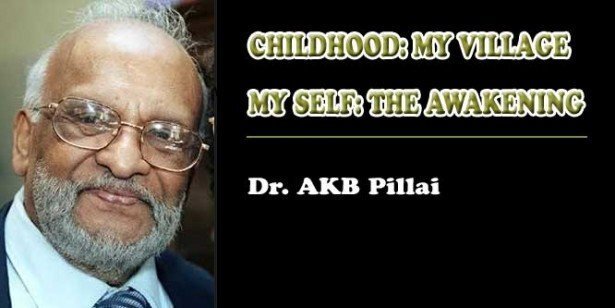CHILDHOOD: MY VILLAGE, MY SELF: THE AWAKENING (Dr. AKB Pillai)

Dr. A.K.B. Pillai
Anthropologist, Author (English & Malayalam) Consultant i Development Therapy. Expert on Education, Writing, Media, Longevity, Religion, Humanization.
Read the autobiography of Dr. Pillai, which will be published in installments in emalayalee. The articles reveal his unusual life and experiences, the historical and contemporary background of the place, people, culture and above all, his insight into everything, which we hope to be inspiring to our readers.
CHILDHOOD: MY VILLAGE
MY SELF: THE AWAKENING
Dr. A.K.B. P I L L A I, PhD.,(COLUMBIA UNIVERSITY, NEW YORK)
[DEDICATED TO: MY VILLAGE, VALADY, MY GRANDFATHER, LATE KALARICKAL PARAMESWARA KURUP, MY MOTHER, LATE NARAYANI AMMA, LATE ARRACKAL-NALLOOR NARAYANA PILLAI, HIS SISTER, LATE SARASWATHI AMMA, HER SON LATE K.C. PILLAI (MANIKKUTTAN)]
The joys of my childhood,- the land, the people and the events are stated below for the joy of yours too. Just like me, please gather joy and inspiration from your past experiences, which constitute great wealth of your life. Further, such efforts would make you joyous in your past relationships and their extensions to their new generations; further, trying to remember the past is an effective means to improve the brainpower, as I myself have been experiencing.
Life is filled with joys and sorrows, successes and failures. If you brood and live with failures, we cannot move forward. On the other hand, if we remember our successes and correct the mistakes of our failures we will move forward and upward.
I. A GREAT PSYCHOLOGICAL DISCOVERY:
MY CHILDHOOD LIFE PROVIDES ME WITH A GREAT PSYCHOLOGICAL DISCOVERY, WHICH IS OUTLINED BELOW
At a time of my infancy and childhood, my family was undergoing severe financial stress, which my grandfather and mother did not let me know. On the other hand, they inspired me to study, socialize me with a creative value system and inspired me with social concerns. This is a great psychological discovery. Now to repeat again, if they put me under the financial stress of the family, I could not have gained any of the accomplishments in my life. I could have become withdrawn and suffering, resulting even in making me a psychologically disordered person, or even a criminal. It was because of that unconditional love toward me to give me everything possible that I took the pathway of learning and development.
MY VILLAGE IS THE JOY OF MY LIFE, AND ALSO THE FOUNDATION OF MY GROWTH AND PERSONALITY.
II. MY MATRILINEAL FAMILY
I am 91 years of age now. I was born and brought up in the village known as Valady, in Kuttanad, an area of rice fields and canals, four miles away from Changanassery, Kerala, India. My family name was Arrackel, meaning house of granary. My family was more than 300 years old as revealed by the old language inscriptions below the foot of the idols of the serpent deities. Evidently, my family held traditionally large areas of rice fields, usually farmed by tenants. At the time I was born, the family had lost most of the lands, because of the mismanagement of uncles. The big ancestral house was demolished. We lived in a small house.
My family belonged to the ethnic group (the old caste system) called the Nayars. The Nayars were matrilineal, that is, the inheritance was from mother to daughter although mother’s brother held authority over the family. In traditional Nayar families, the women were married to the upper caste Brahmin men. They were very religious and ritualized. They let their married wives stay in their own matrilineal homes. They were visited by the Brahmin husbands now and then. My mother was married to a Brahmin priest, by name late sri Venkitachalam Potti, from the Northern state of Karnataka. He was my father. My mother met him at Alleppey, while my grandfather was working there as a legal assistant. In those days my mother spent her life between our house in Valadi, Kuttanad and Alleppey. I was taken care of by my grandfather and mother.
III. MY ASSOCIATION WITH CHRISTIAN FAMILIES
When we lived in Thathampally, a part of Alleppey with my grandfather, my mother moved freely with Christian families around us. An important event from those days is our friendship with a Christian family from the other side of the road. I remember even now a heavily built mother of that house sitting in the middle of buckets of groceries which she sold. She had three or four daughters. The youngest one, Baby, was of my age, around two years. The older daughters would compete to hold me on their waists. Their mother used to warn them not to let my feet rub on the floor. Her daughter, Baby and myself were close friends and we played a great deal together. Once I took from my mother’s kitchen without her knowledge, fried fish and ate with Baby, sitting close together at the back of our house. Many years afterwards when I went to Kerala from the USA I tried to trace Baby’s house, with great difficulty, because the area has completely changed with new buildings. Finally, I located that house. Unfortunately the mother was no more alive. Her granddaughter, a teenage girl, was present in the house. She said Baby was far away, having married. The girl wanted to come to the USA. Even now I feel sorry that I could not help her.
IV. VALLADY: THE PEOPLE AND THE HOUSES
About 160 houses belonged to the Nayars. Six homesteads belonged to carpenters, ironsmiths, and goldsmiths. Two Izhava families and one Kaniyan family were there. Izhavas in the whole Kerala constitute the numerical majority. They were, traditionally small independent farmers, originally believed to be Buddhists and who tried to be independent of the Brahmin dominance. The Kaniyans were the traditional astrologers, practicing country medicine, and even knowing the language of sanskrit. In traditional India the Brahmins did not allow others to study sanskrit, considered to be a sacred language. The Kaniyans not only knew sanskrit, but even taught others, I believe, because they were originally Buddhists.Three houses on the Southern tip of the village and one on the Northern belonged to the Christian community. There was another Christian family in the midsection of the village. On the Southeast edge of the village on the side of a canal was a grocery store run by a Christian community. There was also a small tea shop and another small store selling clothes. The Pulayas, the traditional workers of the rice fields lived on the bunds of the rice fields, away from the island houses of upper castes. The village was self sufficient with skilled caste men, like almost all other villages of India. In Valady, the barbers came from the outside. In most parts of India, self-sufficiency was created by integrating one village with the neighboring villages.
Half a dozen families in the village were petty landlords, owning rice fields. The tenants took care of the farming, as in all over Kerala at that time. They brought a share of the rice crop in big canoes from the rice fields to the landlords’ houses. At the same time the village had at that time many independent small farmers wherein they worked themselves in their farms. In the morning during the farming season I could see and hear many persons going to their fields, some with ploughs on their shoulders and guiding their oxen in the front. The ploughing was done with oxen. Many parts of work in the rice fields such as ploughing, harvesting, etc. were done by working people who were called at the time of the caste system, Pulayas, considered a low caste. The persons of the upper castes did not interact with the lower castes. There were strict ‘untouchability’ meaning persons of the upper class do not touch the persons of the low class. The untouchability has disappeared as it was made illegal in the 1950's. Presently, there is free interaction among persons of all former castes.
An interesting experience was hearing the sounds of tens of thousands of geese and/or storks, flying together far up in the sky from the arctic areas, to their camps in the South, often landing in the open rice fields. We usually came out of the houses to look at them, hearing the sound of their flight. We called them ‘eranda’, meaning the ones that produce soft sounds
One person in his forties called Keyachar, although a Nayar, was a helper in many areas to the Nayar families. He was of low economic position, living in a hut with his wife and children. He was liked by all families because he helped them. In many kinds of household services he was a gentle mannered, calm person.
On the Southern part of our property was a hut of the man who climbed up the coconut trees of the village and cut down the coconuts. He was called Kankali Mannan, meaning the coconut tree climber. He was a short, agile man in his middle age, with a smiling face. He was very affectionate toward me. Sometimes he would go fishing and bring to my house, for me, the best black pear fish. Sometimes late in the night I could hear him singing. My mother thought he was drunk with toddy, a liquor taken from the coconut while they were on the trees. Many houses in the village lent coconut trees to persons who tapped the liquor from the coconut.
My village was cleaned by periodical yearly floods, the waters coming down from the mountains, The rains are very heavy in Kerala, many times with thunder and lightning. On the Northern part of the village is the traditional temple of the Mother Goddess, founded by nine Nayar families, including mine. The people of the entire village participated in the various tasks of weddings and family focused domestic festivities.
V. THE VILLAGE TEMPLES, A RELIGIOUS, SOCIAL AND THEATRICAL CENTER
A few dominant homesteads have in their compounds, open temples of serpent deities. Five homesteads of the Nayars also have open temples of serpent deities, including mine and our branch family, Nalloor. Many years later when individual partition of the family property was enacted, our family lost not only the properties but also the land in which the family Serpent Deities were located. As it represented the lost family, I bought the land and rebuilt the Serpent Deity temple. The Dravidians to whom the majority of the people in South India belong, worshipped the serpent deities with periodical offerings and pujas (rituals). The people have been believing that the serpent deities protected the families, especially with fertility. Anthropologically the serpent deity temples, being surrounded by many plants and trees, a jungle-like area, was the place where the snakes lived. Thus the people have been protected from the snakes. In the evenings, people gathered there for worship and social interaction. The people of the entire village participated in the various tasks of weddings and family focused domestic festivities
My first teacher who taught me my motherton, Malayalam alphabets, was the honored sri Sanku Asan, an old, lean, withered person who was mostly calm and silent. He taught me and other children on the temple grounds, making us write with our fingers, the alphabets on sand. I remember him with great respect.
VI. THE SOCIALLY INTEGRATED KINSHIP RELATIONSHIPS
Everybody in the village knew everybody else, including the children. The children and teenagers roamed through the village pathways and played freely together. If any child did anything wrong, any adult (even not belonging to the child's family) guided the child. At the same time, every child was protected by everybody else in the village. A canal ran through the center of the village. As part of the canals system in between the fields surrounding the village. It was common for me and my friends to play in the shallow waters of the canal. If we played for a longer time, our eyes became red. Any adult of the village who passed through, will ask us to get out of the canal. We obeyed.
VII. MY MOTHER WHO MADE ME SOCIALLY CONCERNED
My mother in her forties was an agile and active woman. It is rumored that she fed me with her breast milk up to two years of age. She was very possessive of me. When we went to our relations’ houses, I would not easily allow them to hold me, because I was very shy. My mother was very social. I believe that I became social because of her. Quite unusual to a Nayar woman, she would take me to the carpenter family who stayed on the second corner of our property. My mother let a friendly, good natured woman by the name Kamalakshy of her age to hold me on her waist while I was around two years of age. I still remember her pleasant manners and happy face. Her father in law, a very famous carpenter-architect of the area, capable of even building temples, wore sacred thread like the Brahmins did. He believed that the carpenter community's ancestor was the Maharishi Vishwakarma, a Brahmin.
My mother was a part time teacher of Thiruvathira, a ritual dance exclusively by women, during religious days, performed mostly in families. Women of all ages in a circle singing with gentle movements of the hands and legs. I should state here that performing Thiruvathira and yoga together constitute the best exercises for women. I am happy to state that the learning of Thiruvathira and dancing is continued today not only in Kerala but also wherever people of Kerala go and immigrate. In every social concern of different Kerala organizations, outside Kerala, especially in Canada and Europe, Thiruvathira is performed with immense enjoyment of the people at large. In the past, Thiruvathira was danced only by upper caste Hindu women. Among the Keralites abroad especially Christian women also take part actively.
In matrilineal families, their women became more in number. They branched out with properties. Nalloor has been Arrackels, main branch family.
There are other branch families in Kavalam, Thanneermukkom, mainly in different parts of Kuttanad. For the last many years, we are having a family organization, meeting during the day of ritual offerings to family Serpent Deities. (To know the complexity of the Nayar culture especially matriliny, created by the Brahmins for social control, read Dr. A.K.B. Pillai, CULTURE OF SOCIAL STRATIFICATION AND SEXIM, THE NAYARS)
I was in the village only a few years of my infancy and childhood. But the memory of the joyous interactions with the nature and people have been lifelong. Like all the villages in Kuttanad, my village is an island surrounded by rice fields, filled with dispersed houses with all kinds of trees: coconut, arecanut, mango, jackfruit, tamarind, etc. Every household has plantain trees, and growing many different vegetables. Many households possessed a cow shed with many cows, mostly, adjacent to the house.
Vallady was dominantly a village of Nayars. In my childhood, the caste system was still dominant in Kerala, with Brahmins on the top, followed by Kshatriyas (In Kerala, the Nayars), below that, the Ezhavas, the carpenters and smiths, and the lowest caste, the Pulayas, the workers in the fields. There were no Brahmin traditional houses in my village.There was one, nearby in the Southern Village. The two Brahmins lived in Vallady as the husbands of Nayar women, of which one was in my own branch family.
VIII. MY GRANDFATHER, THE CREATOR OF MY PERSONALITY
Among all the persons I interacted with in my childhood, the most important was my grandfather. He taught me the stories of the Indian epic, Mahabharata, with their morals, even from when I was two years old. He was a Hindu religious scholar and a very ethical person with strong fellow feelings. I remember that when I was around four years old I captured a duck which usually swam through the canal with half a dozen other ducks. I took the captured duck home and put it under a big basket. My grandfather was not there then. When he came I showed the duck with delight, but he was very upset. He made me take the duck back to the canal and to its home.
My grandfather, Late Kalarickal Parameswara Kurup is called by other persons of his age, respectfully, ‘Asan’, meaning teacher. His family name, Kalarickal, means ‘house of teaching karate’. Evidently, the members of his family traditionally taught karate. But they were not teaching in my childhood.
He was a retired legal assistant in the town Alleppey, sixteen miles away. But when his eyesight diminished because of cataracts he stopped working. But he was a legal expert. Many persons came and consulted with him about their legal issues. He was also a good friend to many persons in the village. He was at that time in his 60s. Persons around that age frequently came to our house and visited him for social interaction.
It was my grandfather who taught me many things of life. His affection toward me was of unconditional love. I remember, as a teenager while I was in Nallur, chettan gave me an English paperback by Peter Cheyni. He encouraged me in my studies. He was always gentle and affectionate toward me. I had never seen him angry or irritated, except when he found out that I took that duck from the canal to the house, which he made me to return. That was a great lesson in life that I learned from him. I remember him, when I was of two years of age holding me on his shoulders, my legs dangling on either side of his neck, walking through Alleppey. Once when he took me to the Judicial Court, he picked up a beautiful feather from the ground and gave it to me. I believe that it was his blessing to me to become a writer and a thinker. He made very good pens by cutting the edges of the feathers. He also made writing ink, himself. He was also an expert in copying Malayalam epics with an iron pen, on cured palm leaves. After inscribing, they are tied together. Until the paper making took place, all the documents and religious writings were inscribed with an iron needle on cured palm leaves which remained undamaged for hundreds of years. Every upper caste household had a treasure of palm leaf records. In the Manuscripts Library of Kerala government, in Thiruvananthapuram there is a large collection of palm leaves manuscripts, including unpublished precious writings.
As I stated earlier, my village, the nature and people there have given me permanent joy in my life. Even in my childhood I used to walk along, sometimes with grandfather or mother on the banks of the canals to see the rice fields and the water. Once I saw many small species of three to four inches long, catfish, hundreds of them being together on the side of a canal as if they were playing Thiruvathira. !
( To be continued)





